If you want up-to-date browser stats, then you’ll LOVE this comprehensive roundup.
Today, I will show you which browsers have the biggest slice of the 5.65 billion monthly internet users today – the competition is fierce!
This guide will break down the top statistics by desktop, mobile, tablet, and location.
Let’s explore the rise and fall of the internet’s largest browsers.
Worldwide Browser Market Share in 2025 (All Platforms)
Here’s a breakdown of browser share worldwide for desktop and mobile. As you can see, Chrome is by far the most popular browser on the planet (nearly 8 out of 10 people use Chrome), followed by Safari.
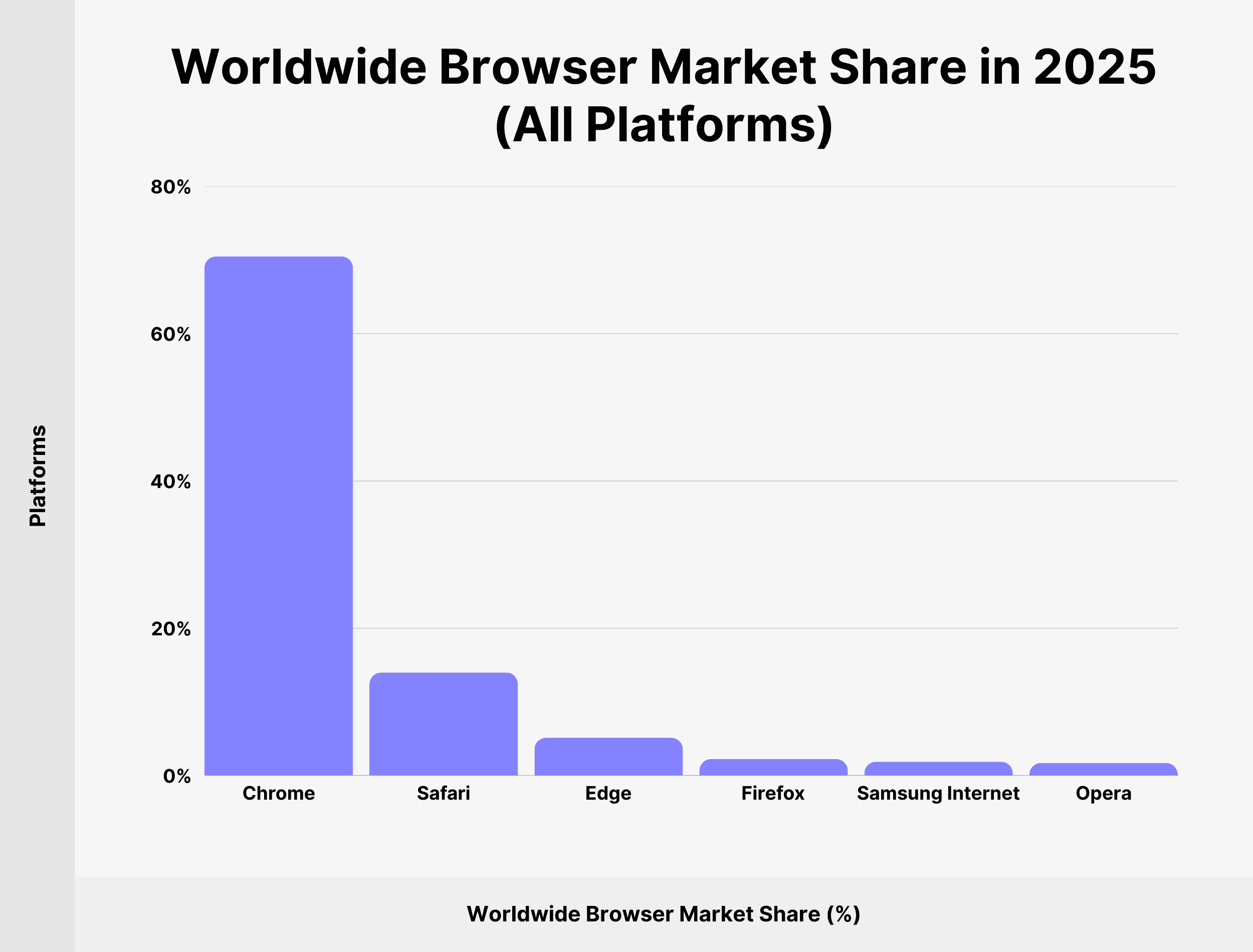
Interestingly, the relatively new Microsoft Edge has surpassed Firefox in popularity.
| Chrome | Safari | Edge | Firefox | Samsung Internet | Opera |
|---|---|---|---|---|---|
| 70.5% | 14% | 5.15% | 2.25% | 1.93% | 1.72% |
Desktop Browser Market Share in 2025
Looking at only desktops, the rankings are similar, but we’ve got a new browser (360 Safe) not featured in the ranking of most popular browsers across all platforms.
Also, Edge appears to be a browser that people primarily use on desktops, and it took Safari’s second place in the overall ranking.
| Chrome | Edge | Safari | Firefox | Opera |
|---|---|---|---|---|
| 71.17% | 11.92% | 6.01% | 4.72% | 1.84% |
Mobile Browser Market Share in 2025
Chrome remains the #1 most-used browser on mobile and desktop. Safari, largely thanks to being the default browser on iOS devices, comes in at a relatively close second.
| Chrome | Safari | Samsung Internet | Opera | UC Browser | Android |
|---|---|---|---|---|---|
| 70.6% | 19.19% | 3.27% | 1.84% | 1.64% | 1.13% |
Google Chrome Browser Market Share Statistics
How Many People Use Google Chrome?
Google Chrome holds over 70.5% of the browser market share in September 2025.
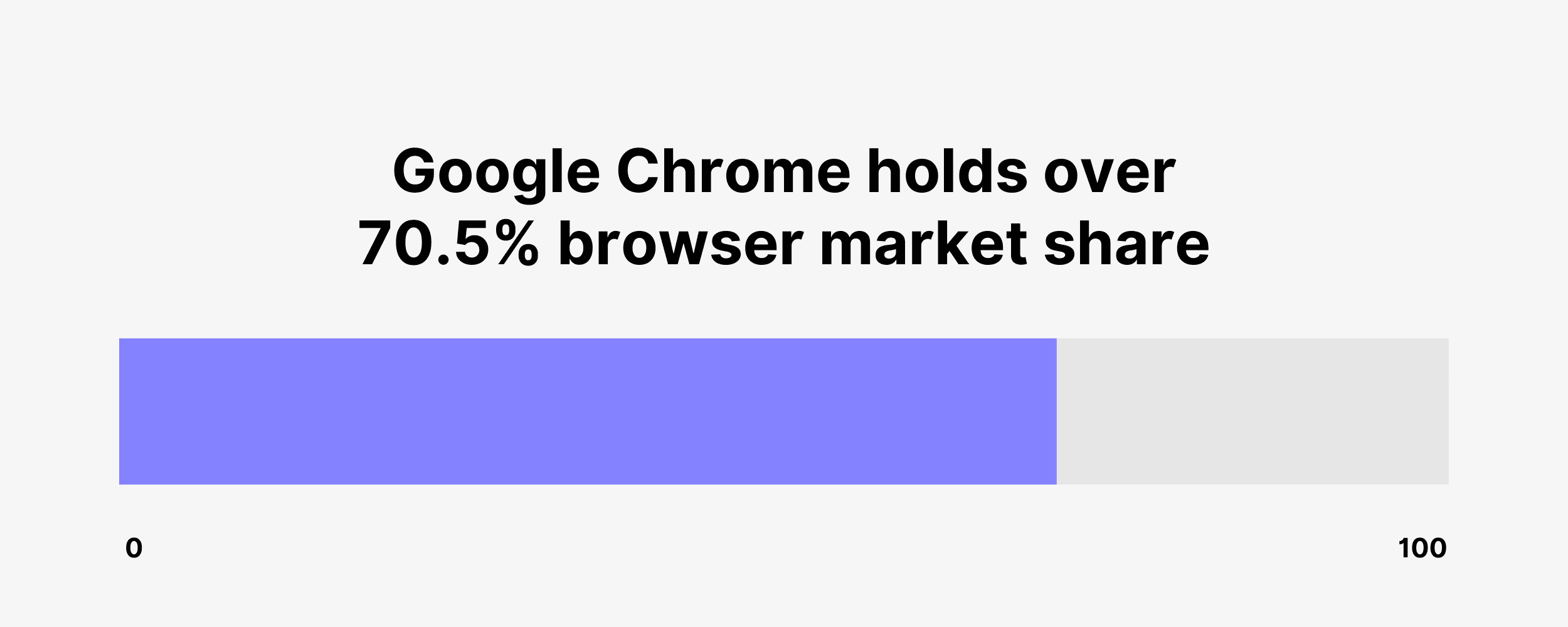
Considering there are 5.65 billion internet users, the number of people using it is estimated to be 3.98 billion worldwide.
Google Chrome Browser Market Share Worldwide in 2025
| All Platforms | Desktop | Mobile | Tablet | Console |
|---|---|---|---|---|
| 70.5% | 71.17% | 70.6% | 48.2% | 0.29% |
Chrome Browser Usage Statistics
- Number of people using Chrome: 3.98 billion worldwide
- 12-month growth: 65.74% to 70.5% (2024-2025)
- 10-year growth: 45.83% to 70.5% (2015-2025)
- Highest market share: 70.5%
- Growth trend: From 2008 to 2022, there was an upward trend year-over-year. Since then, growth has somewhat plateaued, although there have been further increases since 2024.
Google released the initial version of Chrome back in September 2008. Before this, we lived in a world dominated by Mozilla Firefox and Microsoft’s IE.
Today, they barely hold 10% of the browser market combined (when accounting for Edge replacing Microsoft’s IE).
Chrome also remains the dominant web browser worldwide. In fact, Chrome is now the largest browser in pretty much any country, platform (except console), apart from Apple’s Safari being dominant on US mobile devices.
Notable Statistics
- As of May 2024, Chrome is 1-in-9 apps to be downloaded over 10 billion times from Google Play. What’s more, the other top 8 are all Google apps: Google Play Services, YouTube, Google Maps, Gmail, Speech Services by Google, Google Search, Android Accessibility Suite, and Google Drive.
- Chrome pays hackers to hack them – that’s right; they have a Chrome Vulnerability Reward Program where you can get paid up to $150,000 for exploiting vulnerabilities.
Summary
I think one of Chrome’s crowning features is its continuous evolution.
Google’s statistics do the talking. They’re consistently improving the browser’s security, performance, and functionality – not to mention the awesome Chrome extensions!
Overall, it may not be perfect with resource usage and other issues, but people keep installing it on their devices, so they’re doing something right!
Sources: Statcounter, Statcounter, Statcounter, Wikipedia
Safari Browser Market Share Statistics
How Many People Use Safari?
Apple’s offering, Safari, currently holds 14% of the internet browser market, with an estimated 0.79 billion people using it in September 2025.
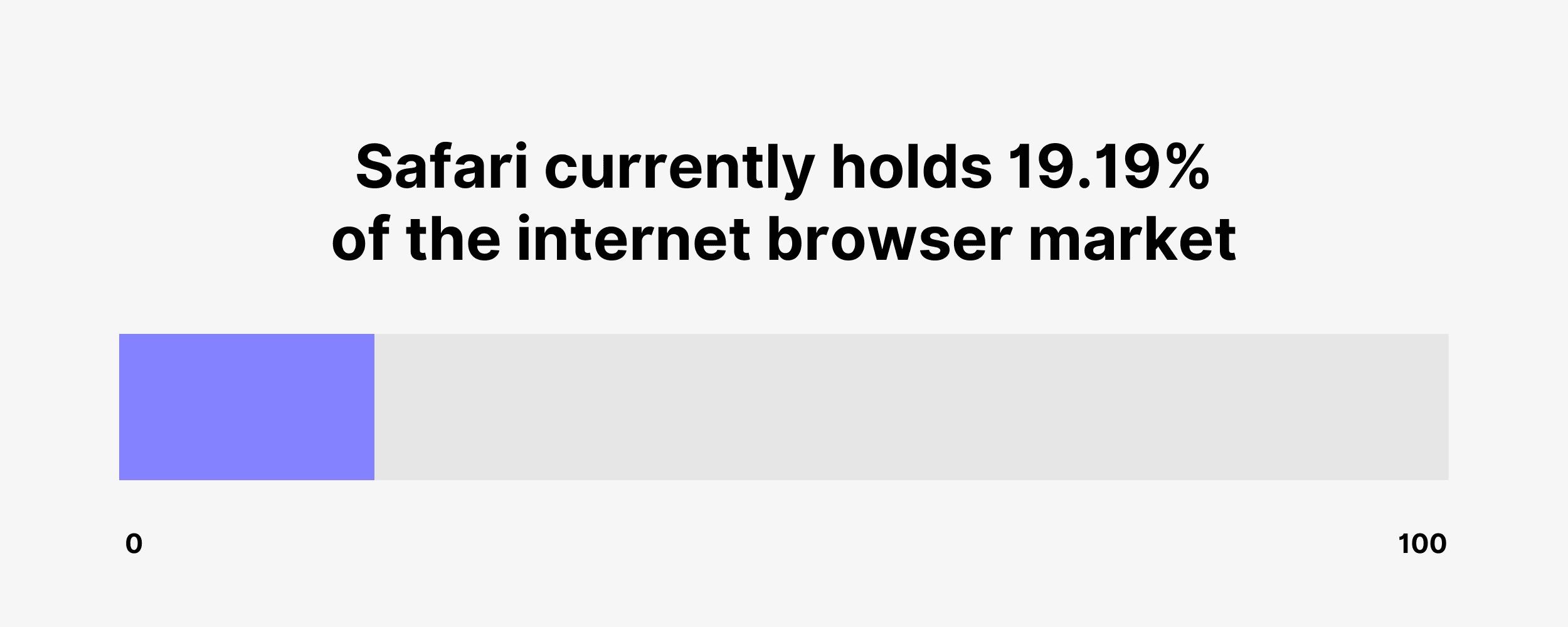
Safari also makes up 19.19% of all mobile device browsers worldwide, which is high considering Apple holds 27.13% of the smartphone market.
Safari Browser Market Share Worldwide in 2025
| All Platforms | Desktop | Mobile | Tablet |
|---|---|---|---|
| 14% | 6.01% | 19.19% | 30.92% |
Safari Browser Usage Statistics
- Number of people using Safari: 1 billion worldwide
- 12-month growth: 18.21% to 14% (2024-2025)
- 10-year growth: 12.1% to 18.01% (2015-2025)
- Highest market share: 20.7% (May 2023)
- Growth trend: Since 2009, Safari usage share has only decreased notably on two occasions: 2014-15 (-0.71%) and 2024-25 (-4.09%)
- Release date: January 7, 2003 (Replacing Navigator on Macintosh computers)
Safari replaced Navigator as the browser of choice on Macintosh computers back in January 2003. Since then, Safari has been the default, pre-installed browser on every single iOS device with internet access.
No guesses what the primary driver for its user popularity is, right?
General Statistics
- Safari is the #1 browser for US mobile users, with 50% of Americans using it for their mobile devices.
- Originally, Safari was going to be named ‘Freedom’ by Apple’s creator, Steve Jobs.
- The developers pushed for the name ‘iBrowse.’
- Safari is a firm number 2 in the market; its steady growth in the last decade has seen it reach a usage share of 1-in-5 web users in February 2025
Summary
Overall, we can see that Safari is the second most popular browser globally.
In the US mobile market, Safari is still going strong in terms of dominance. Until more Android devices are sold than iOS in America, it’s not likely to change any time soon.
At the moment, it seems users have to choose if they want the privacy and security benefits of Safari or just to use Chrome, which basically wants to collect data and advertise stuff to you.
Sources: Statcounter, Statcounter, Statcounter, Statcounter, Ars Technica
Mozilla Firefox Browser Market Share Statistics
How Many People Use Firefox?
In terms of the total web market share, Mozilla’s Firefox currently holds 2.25% across all platforms in September 2025.
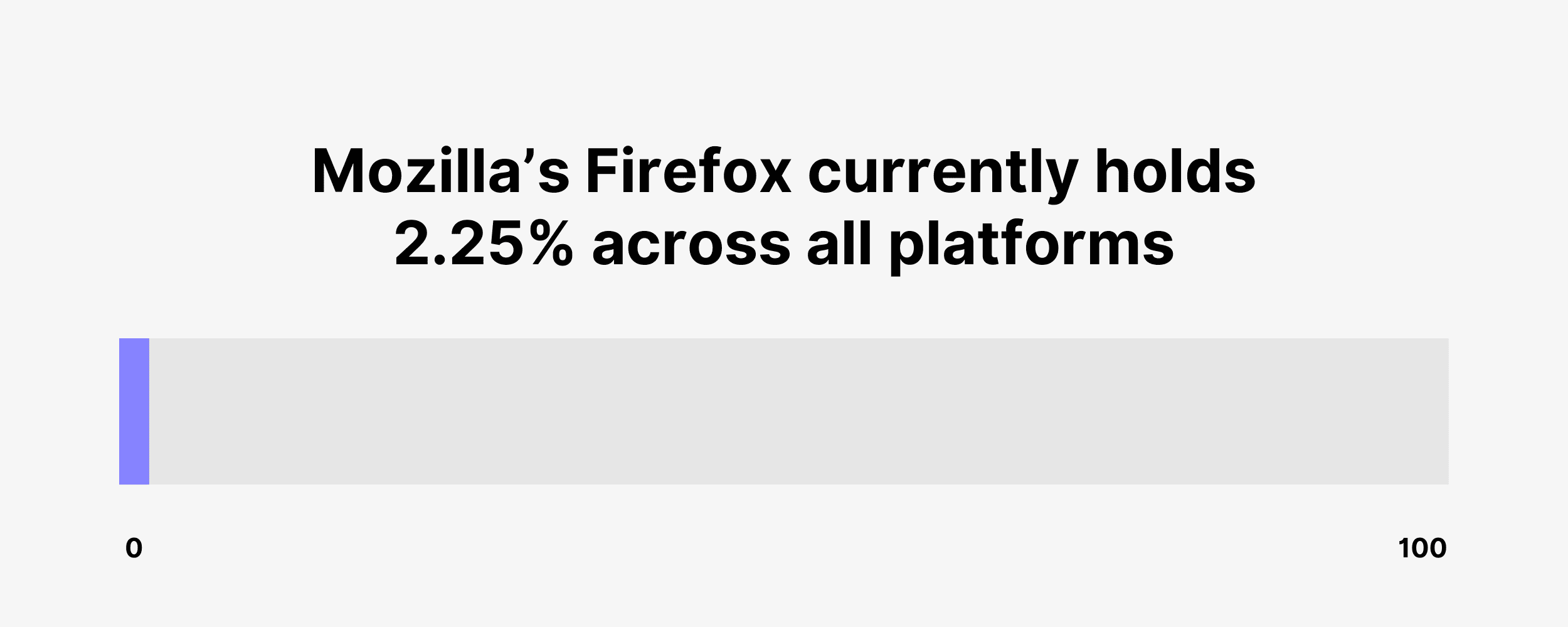
With only 0.54% coming from mobile devices. It’s estimated that 305 million people use Firefox today.
Firefox Browser Market Share Worldwide in 2024
| All Platforms | Desktop | Mobile |
|---|---|---|
| 2.25% | 4.78% | 0.54% |
Mozilla Firefox Browser Usage Statistics
- Number of people using Firefox: 305 million worldwide
- 12-month growth: 2.72% to 2.25% (2024-2025)
- 10-year growth: 9.83% to 2.25% (2015-2025)
- Highest market share: 31.82% in November 2009
- Growth trend: Since 2009, there has been a consistent decline in market share (with limited month-to-month growth in a few cases)
- Release date: September 23, 2002 – Called Phoenix 0.1
Since Phoenix 0.1 was released in September 2002, Firefox quickly became a user favorite and a renowned alternative to the once-dominant Internet Explorer. The fast adoption of Firefox was mainly due to IE’s slow release and lack of new features.
There was a time in the mid-2000s to 2010 when every 1 in 3 people accessing the web used Firefox. Since 2009, it’s lost its popularity considerably to Chrome and Safari, dropping from 10.51% to 2.25% in the past 10 years.
General Statistics
- On Google Play’s Android store, the Firefox app has over 100 million downloads.
- Firefox is a non-profit organization.
- Today, over 20% of Firefox users have the ‘Enhanced Tracking Protection’ feature enabled, blocking third-party tracking cookies.
Summary
Mozilla is a non-profit.
Because of that, users of the browser benefit from slightly more privacy compared to the amount of ad data Google collects from your search history via Chrome.
If privacy is something you look for in your internet experience, then browsers like Firefox and Tor are the best place to start.
Sources: Statcounter, Statcounter, Statcounter, Statcounter, Mozilla, Mozilla
Microsoft Edge Browser Market Share Statistics
How Many People Use Edge?
In September 2025, Microsoft Edge had 4.85% of the worldwide browser market, with an estimated 274 million people using it today.
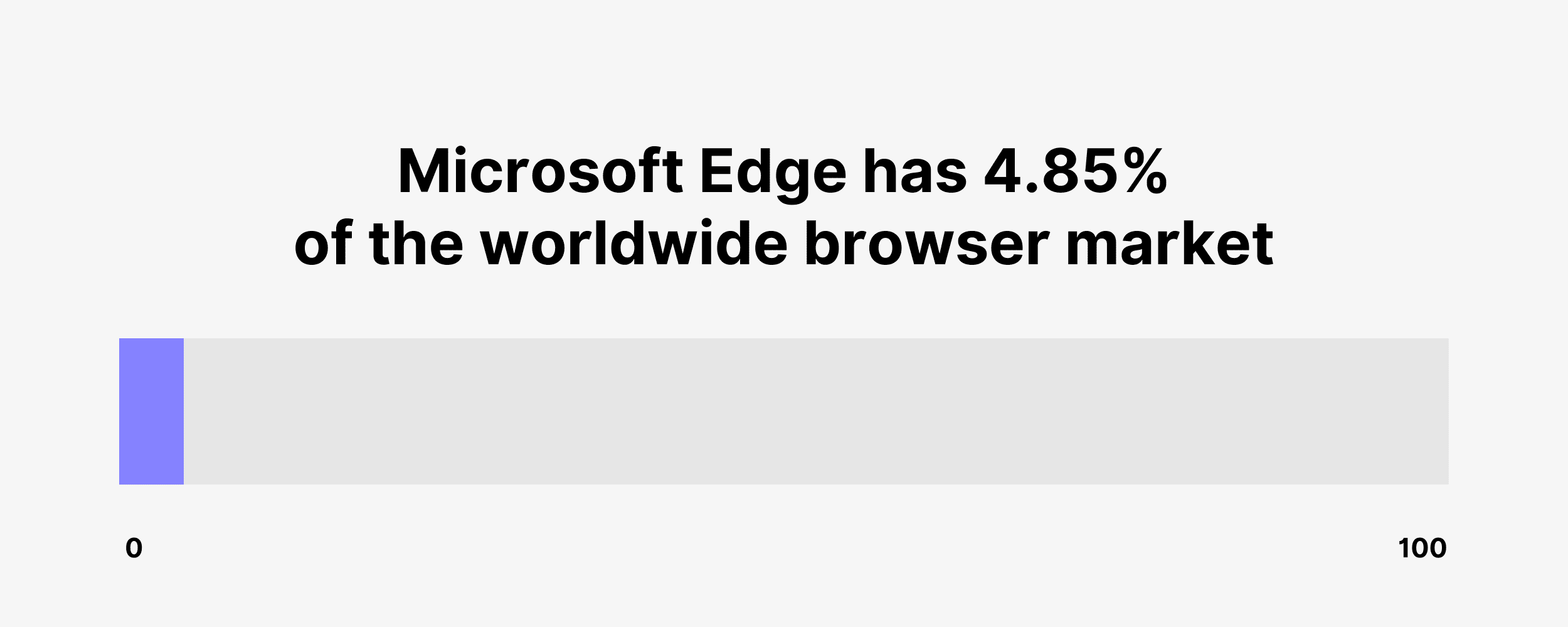
Edge performs well in the desktop market share at 11.8%, and a much lower 0.47% for mobile browser use.
Microsoft Edge Browser Market Share Worldwide in 2025
| All Platforms | Desktop | Mobile | Tablet | Console |
|---|---|---|---|---|
| 4.85% | 11.8% | 0.47% | 1.35% | 66.34% |
Edge Browser Usage Statistics
- Number of people using Edge: 274 million worldwide
- 12-month growth: 5.32% to 4.85% (2024-2025)
- Growth since launch: 1.45% to 4.85% (2020-2025)
- Highest market share: 5.5% in November 2023
- Growth trend: Marginal year-over-year increases
- Release date: July 25, 2015
Since launching on July 25, 2015, Microsoft’s replacement for IE has taken a good slice of the market, although not as much as the company hoped with its awe-inspiring codename ‘Spartan’.
The original Edge was an HTML-based browser. As of January 2020, Microsoft launched its Chromium-based version, merging users into the compatibility and performance-focused version.
Additional topics & snippets
As we know from Internet Explorer, simply installing something as the default does not suggest that people will switch to use it as the default. However, people seem to be giving Edge a shot, and the year-over-year growth has been consistent.
Will Edge manage to overtake Safari?
Only time will tell.
Sources: Statcounter, Statcounter, Statcounter, The Verge
Samsung Internet Browser Market Share Statistics
How Many People Use Samsung Internet?
In September 2025, Samsung Internet’s share of the web browser market was 1.93% across all platforms, with over 109 million people using it worldwide.
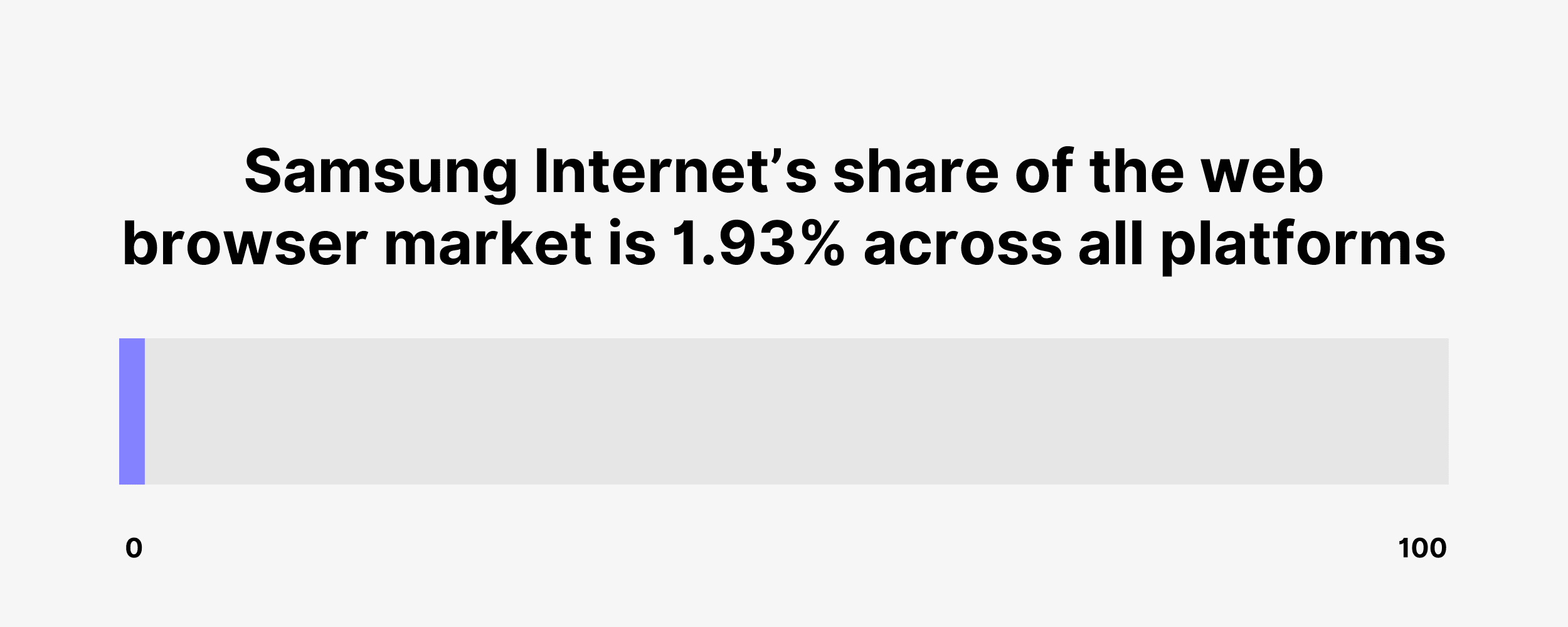
However, the focus should be on their 3.25% of mobiles.
Samsung Internet Browser Market Share Worldwide in 2025
| All Platforms | Mobile |
|---|---|
| 1.93% | 3.25% |
Samsung Internet Browser Usage Statistics
- Number of people using Samsung Internet: 109 million worldwide
- Downloads on Google Play: 1+ billion
- 12-month growth: 2.4% to 1.93% (2024-2025)
- Growth since launch: 0.55% to 1.93%
- Highest market share: 3.75% in July 2019
- Growth trend: Since launch, it has grown its market share to over 3% in 2019, but usage has slightly dropped since
- Release date: 2015
Samsung Internet is a mobile device browser running on the open-source Chromium project. It can be found on many smartphones.
What’s more, Samsung Internet has received over 1 billion installs from the Google Play Store since 2015, which is more than several browsers like Firefox and Opera combined.
These installs have left Samsung Internet ranked the 6th most popular browser across all platforms worldwide, behind Chrome, Safari, Edge, Firefox, and Opera. In terms of mobile, where it’s available for install, Samsung is ranked the third most used, behind Chrome and Safari.
Sources: Statcounter, Statcounter, Statcounter, Google Play
Browser Market Share by Country
1. China Browser Usage Statistics
Internet users: 1.11 billion
| Chrome | Edge | Safari | Android | UC Browser | 360 Safe Browser |
|---|---|---|---|---|---|
| 52.52% | 11.44% | 10.25% | 9.56% | 4.68% | 3.61% |
Again, Chrome is the most popular internet browser in China, with a 45.12% market share.
Microsoft’s offering Edge ranked second with an 11.44% market share across all platforms and 17.88% among desktop users, ranking it only behind Chrome in the desktop category.
Safari comes in third with a 10.25% market share; one contributor is the 44.43% dominance they have in the tablet market as the browser of choice.
Android Browser was the fourth most popular browser in China, with 9.56% on all platforms, 19.05% on mobile.
2. India Browser Usage Statistics
Internet users: 806 million
| Chrome | Opera | Safari | UC Browser | Samsung Internet |
|---|---|---|---|---|
| 92.3% | 2.29% | 1.89% | 1% | 0.84% |
Chrome is the undisputed top-ranked browser for India’s market share, with 92.3% across all devices and 92.77% on mobile. The second place is Opera with 2.29% overall and 2.46% through cell phones.
Safari doesn’t claim any wins for market share across all platforms, with 2.06% on mobile and only 8.45% on tablets – a market the company typically excels in.
This difference is due to the smartphone market; budget phones like Xiaomi, Realme, and OPPO dominate phone sales in India.
The UC browser had a 50/50 market share with Chrome until 2016, when it saw a decline in users migrating to Chrome.
UC did so well initially because it offered a lite mode that reduced the data usage, allowing for 2G browsing. What’s more, they actually saved 79% more data than Chrome and Firefox on a 1000 MB web page load in tests.
3. USA Browser Usage Statistics
Internet users: 322 million
| Chrome | Safari | Edge | Firefox | Samsung Internet | Opera |
|---|---|---|---|---|---|
| 52.71% | 29.28% | 7.36% | 4.09% | 1.54% | 1.15% |
At 52.71% Google Chrome is the most popular across all platforms in terms of the US browser market share. In second place is Safari with 29.28% of the share; together, they make up over 81.99% of America’s market.
In terms of mobile, Safari is ranked number one and makes up 49.98% of all mobile browsing in the US, with Google Chrome ranked second with 41.94% and the Galaxy phones’ default browser, Samsung Internet, at 3.43%.
Why is Apple so dominant?
Well, this boils down to the simple fact that they sell more phones in America than any other company. The iPhone’s default browser is Safari, and it owns 55% of the smartphone market in the US, followed by Samsung at 23%.
Sources: Datareportal, Statcounter
Browser Market Share By Region
Finally, below we can see a comparison of all regions.
Where Safari has some strong usage figures in North America, Europe, and Oceania, it’s still too far behind Chrome.
Chrome is here to stay across all regions.
We can expect the most significant changes to these browser usage figures to come from the influence of pre-installed browsers on mobile devices.
Asia Web Browser Statistics
Almost 8 out of 10 internet users in Asia use Chrome. And less than 2% use Opera.
| Chrome | Safari | Edge | Samsung Internet | UC Browser | Opera |
|---|---|---|---|---|---|
| 78.93% | 8.15% | 3.57% | 1.58% | 1.86% | 1.37% |
North America Web Browser Statistics
In North America, Chrome holds a slim lead in terms of market share, with Safari being used by around a third of all North American internet users.
| Chrome | Safari | Edge | Firefox | Samsung Internet | Opera |
|---|---|---|---|---|---|
| 53.8% | 29.12% | 7.1% | 3.78% | 1.56% | 1.11% |
South America Web Browser Statistics
In South America, Chrome dominates. Nearly 8 in 10 internet users in South America use Chrome as their browser of choice.
| Chrome | Safari | Edge | Opera | Firefox | Samsung Internet |
|---|---|---|---|---|---|
| 88.3% | 4.09% | 3.97% | 1.29% | 1.23% | 0.94% |
Europe Web Browser Statistics
Here’s a full breakdown of browser market share in Europe. In the European region, Firefox has a much stronger presence than in Asia or South America.
| Chrome | Safari | Edge | Firefox | Samsung Internet | Opera |
|---|---|---|---|---|---|
| 59.73% | 18.99% | 6.94% | 4.65% | 3.41% | 2.43% |
Oceania Web Browser Statistics
In Oceania, Chrome retains a slim lead over its competitors. Even so, over half of all internet users in Australia, New Zealand, and other countries in the region use Google Chrome.
| Chrome | Safari | Edge | Samsung Internet | Firefox | Opera |
|---|---|---|---|---|---|
| 58.79% | 26.02% | 7.22% | 2.58% | 2.5% | 1.11% |
Africa Web Browser Statistics
Chrome also performs well in Africa. However, Opera has much higher market penetration in Africa compared to many other places in the world.
| Chrome | Safari | Opera | Samsung Internet | Edge | Firefox |
|---|---|---|---|---|---|
| 74.53% | 8.06% | 7.67% | 3.43% | 3.3% | 1.5% |
Conclusion
That’s a wrap for my roundup of browser statistics.
Chrome is the unquestionable champion in the browser wars. Yet, some other browsers made category or regional wins, questioning global Chrome dominance.
Backlinko is owned by Semrush. We’re still obsessed with bringing you world-class SEO insights, backed by hands-on experience. Unless otherwise noted, this content was written by either an employee or paid contractor of Semrush Inc.

